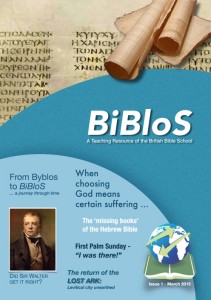Most of us notice but some of us do not: all sentences start with a capital letter, contain a finite verb, and end with a full stop. This is the way we punctuate nowadays but of course not all languages punctuate in the same way. The Bible, to take an important example, contained much less punctuation when written than we might expect. However when we look deeper we see that the writers of the Bible did things differently. We take paper and pens for granted but these were luxury items to the ancients. Indeed paper as we know it did not exist. Either animal hides were scraped clean to make vellum, or papyrus plants were cut into strips and rejoined to make papyrus. Both were expensive and so would not be wasted. In the Ashmolean Museum in Oxford there is a piece of broken crockery on which a letter had been written. It starts off with “My dear friend, I must apologise for writing to you on this broken plate but it was all I could find.” Paper – or papyrus – was such a luxury the scribes did not want to waste any of it. So Hebrew writers left out vowels and Greek and Roman writers did not leave any gaps between words and without gaps between words there is nowhere to put the punctuation. The later invention of word-gaps was criticised by some for making it too easy to read God’s word. PraisetheLordthattheylostthatbattle!
There is much that we take for granted that was not in use back then. Speech marks, for instance. Take that most famous of Bible verses: John 3:16. “For God so loved the world.” We know it but we do not know who said it. Was it Jesus speaking or John commenting on what Jesus had just said? Either way the meaning is the same but we do not and cannot know from the text who actually said the words. However the ancients did have other ways of conveying sense where we would punctuate. When a later writer was passing on information he had heard from someone else he would make it clear. Not with speech marks and a footnote but by saying so both at the beginning and end. “My grandfather told me. . .” followed by the anecdote and then closed with “That’s what my grandfather said.” Which sounds like the way an oral society would transmit memories; memories that would eventually become history.
Stories – fiction, we would say – would be identified differently. We are familiar with “Once upon a time” which are not the words the ancients used but it gets across the point: this story is made up and I, the story teller, can change it to suit my needs.
So if I am telling it in Athens I can add local colour: “Once upon a time the goddess Athena visited her city Athens and. . .” And when I am in Corinth it becomes: “Once upon a time the goddess Aphrodite visited her city Corinth and. . . .” The same recipe but different ingredients and signalled differently than something that was believed to be true.
In the Gospels we are dealing with truth. Fact, not fiction. We need to remember the opening words of L. P. Hartley’s novel The Go-between.
“The past is a foreign country, they do things differently there.”
Note the speech marks!
The Gospel writers did things differently. Not necessarily better or worse but different. In a modern biography we would expect the author to state his – or her – sources, usually in the form of a foot-note; to use quotation marks to indicate when the exact words are being given; to distinguish between direct quotes and a general summary of what was said.
We distinguish between historical writing, biographical writing, and news reports. The ancients did not define these writings quite as we do. History, for them, tended to be beyond living memory and concerned much more with political and military matters than personal, biographical material. History was what happened back in the days of our grand-parents’ grandparents. Many of us have known at least some of our grandparents but knowing your grandparents’ grand-parents is much less likely and probably has not happened since the earliest chapters of Genesis. So to find out about our grandparents’ grandparents and their life and times we have to use other forms of knowledge beyond eyewitness testimony.
But the gospels – Matthew, Mark, Luke, and John – were written within the life times of many eyewitnesses. This was an expectation of ancient biography, that the life of a famous man (or, much more rarely, a famous woman) would be told in the words of those who saw and heard what made him famous: the eyewitnesses.
If you were planning on writing the story of Jesus we would expect to meet certain people in the pages of your book. Jesus, obviously; His parents; His friends – and enemies. And some of the famous people in the background. The Roman Procurator, for example: Pontius Pilate; the Jewish High Priest: Caiaphas. Both present and correct. Thanks to the work of archaeologists we now know thousands of names from Roman-occupied Judaea. Some are Latin or Greek but most are Hebrew, although the Jews at the time did not tend to use many different names, preferring to keep to traditional ones. Sometimes there was a patronymic element: “son of”; or ‘bar’ in Hebrew. So we meet Bar-ptolemy or Bartholomew to use the Anglicised version. Then there is Bar-abbas, Simon, bar Jonas and so on. Or nick-names: Cephas (Peter in Latin), the Rock; Simon the Zealot and so on. And the names in the New Testament fall well within the range of what we would expect. We would recognise when a name sounds wrong. We read a Jeeves and Wooster story, for example. That’s Reginald Jeeves and Bertram Wilberforce Wooster, written by Pelham Greville Wodehouse.  Their Christian names date them for us: Edwardian. So if a Wayne or Kylie walked into a Jeeves and Wooster story we would do a double-take. Those names were not used back then. Likewise the names in the New Testament ring true. Actually, there are a surprising number of names given, some of which seem superfluous. Take Blind Bartimeus, for example. Why does Mark bother to name him in chapter ten? Why not just tell about the blind man that Jesus made see again? And Jairus whose daughter died in chapter five? Why not just describe him as the synagogue official? Could it be that these names are given because they were known to be eyewitnesses? Had they met Jesus, later been added to the church, and told their story to any and every one? So that when Mark wrote down what they told him he fixed their names in the record. I believe that this is possible, probable, even.
Their Christian names date them for us: Edwardian. So if a Wayne or Kylie walked into a Jeeves and Wooster story we would do a double-take. Those names were not used back then. Likewise the names in the New Testament ring true. Actually, there are a surprising number of names given, some of which seem superfluous. Take Blind Bartimeus, for example. Why does Mark bother to name him in chapter ten? Why not just tell about the blind man that Jesus made see again? And Jairus whose daughter died in chapter five? Why not just describe him as the synagogue official? Could it be that these names are given because they were known to be eyewitnesses? Had they met Jesus, later been added to the church, and told their story to any and every one? So that when Mark wrote down what they told him he fixed their names in the record. I believe that this is possible, probable, even.
But there is more. As we said earlier, there was the way of book-ending a remembered story by introducing the person who told the story and then concluding with the same name. “My grandfather told me. . . The story. . . That’s what my grandfather said.” (The technical name for this is inclusio.) So when we read a name at the beginning of a story and then see the same name at the end we should be alert to what is happening. If we go to the start of Mark’s gospel, the first disciple we meet is Simon Peter. In Mark 1: 16 we read:
“As Jesus was walking by Lake Galilee he saw Simon and Andrew, Simon’s brother.”
Some translations skip the second mention of Simon and say that Jesus saw Simon and his brother Andrew, not Simon and Simon’s brother. It seems that Mark is emphasising that Simon is the main man here, not his brother Andrew. And the last disciple to be named by Mark is Simon, except that now he is Peter. In 16:7 we read:
“But go and tell the disciples and Peter.”
So Mark starts with Simon and ends with Peter and in between it is Peter who is named the most. Twenty-eight times as either Simon, Simon Peter, or Peter. John is next with twenty-five name-checks and the two James (the son of Alphaeus and the son of Zebedee) manage double figures, with fifteen between them. None of the other disciples reach double figures. Could it be that Mark is telling Peter’s story? I believe that the internal evidence from within Mark’s Gospel tells us that it is, using the techniques available to him. Also I believe that there is compelling evidence from outside of the Gospel that confirms this, which is what we will look at next time.
(To be continued …)
Steven Whitehead
 This article is from BiBloS, a teaching resource of the British Bible School. To read more articles or download the whole of Issue 1, click here.
This article is from BiBloS, a teaching resource of the British Bible School. To read more articles or download the whole of Issue 1, click here.

